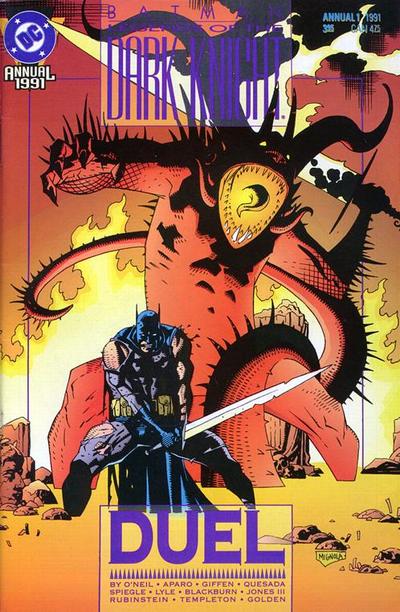 |
| Mike Mignola |
The first annual was published in 1991 and titled “Duel”. It presents a very unique story about Batman that is, more than anything else, an oneiric journey through the most unexpected landscapes that one could think of. If it is true that often Batman stories have been set in realistic, urban environments, then it is also true that the character has the potential to thrive in very different scenarios, and that is what we can see in this amazing annual which also combines the talents of some of the most famous artists in the comic book industry.
The opening a splash page is by none other than Jim Aparo, another legendary Batman artist who has been famous for his work on the character throughout the decades. This Magnificent composition gives us a dark silhouette, the Dark Knight himself, while trying to walk across the snow. Even if Batman is a character that can only exist at night he still looks like the superhero we all know in this very unusual setting.
Can Batman survive in the snow? This seems to be the first question that the readers will be asking but there is much more to come because Keith Giffen and Malcolm Jones III take Batman to hell, making him fight against demons while trying to carry a burden which can also be seen in the previous sequence. Batman will be carrying this burden, this strange luggage that sometimes seems to change depending on the context, he might be unsure as of why he needs to keep carrying it but he never lets go of it, and he constantly comes back to it. Keith Giffen was famous for his work in the Legion of Super-Heroes and what is especially interesting as finding somebody like Malcolm Jones III inking the work of a man who has become synonym with the superheroes of the 31st century.
 |
| Jim Aparo |
 |
| Keith Giffen & Malcolm Jones III |
________________________________________________________________________________________________
________________________________________________________________________________________________
Cuando Legends of the Dark Knight empezó a publicarse, se anunció como el primer nuevo título mensual de Batman desde los 40s. Para celebrar una ocasión tan trascendental, tuvimos al legendario escritor Denny O'Neil y su arco Shaman. El primer año de Legends of the Dark Knight fue increíble en términos de calidad pero también en términos de talento: Grant Morrison escribió Gothic y luego Doug Moench escribió Prey. Por supuesto, como es una tradición con títulos mensuales, habría más de una oportunidad para un anual de Legends of the Dark Knight.
 |
| Joe Quesada & Joe Rubinstein |
 |
| Tom Lyle & Ty Templeton |
 |
| Dan Spiegle |
 |
| James Blackburn & Michael Golden |
Por supuesto, también hay desplazamientos temporales, por lo que podemos ver a Batman luchando contra la mafia en 1930. El arte es de Dan Spiegle. Quizás el momento más alucinante tiene lugar cuando Batman debe enfrentarse a los soldados nazis comandados por el mismísimo führer, Adolf Hitler; por supuesto, como cualquier lector podría adivinar, nada de esto sería posible en una historia convencional, ello significa que algo más está sucediendo aquí. James Blackburn y Michael Golden se encargan de ilustrar estas últimas páginas. ¡Y, por supuesto, nadie podría pasar por alto la sorprendente portada de Mike Mignola! Creo que Denny O'Neil hace un gran trabajo al combinar todos estos hilos argumentales, aparentemente sin relación, en una historia sólida y entretenida que realmente está a la altura del fantástico primer año de Legends Of The Dark Knight.





